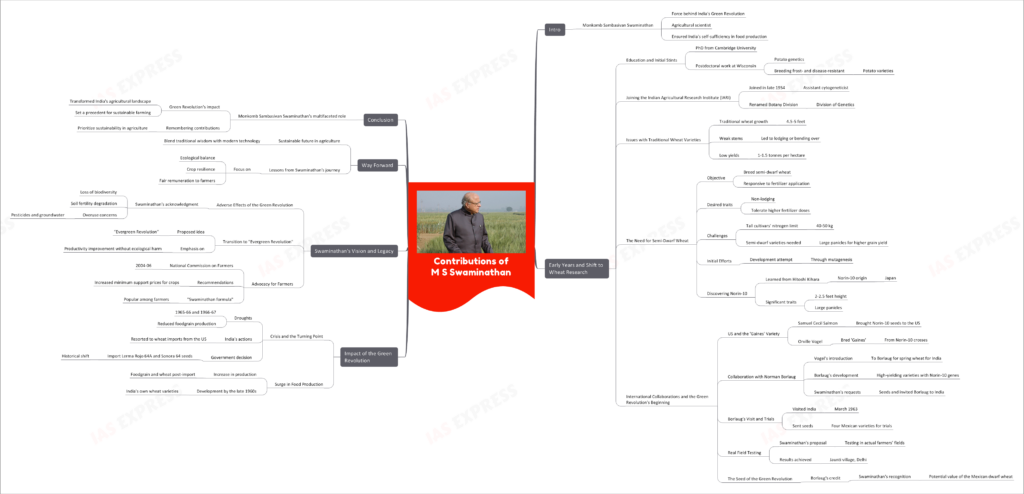Contributions of M S Swaminathan- Why are they Significant?
Monkomb Sambasivan Swaminathan, recognized as the force behind India’s Green Revolution, was an agricultural scientist who played a crucial role in ensuring India’s self-sufficiency in food production. His contributions spanned both the inception and the long-term vision of sustainable agriculture.

This topic of “Contributions of M S Swaminathan- Why are they Significant?” is important from the perspective of the UPSC IAS Examination, which falls under General Studies Portion.
Early Years and Shift to Wheat Research
Education and Initial Stints
- Attained PhD from Cambridge University, UK.
- Postdoctoral work at Wisconsin, US, focusing on:
- Potato genetics.
- Breeding frost- and disease-resistant potato varieties.
Joining the Indian Agricultural Research Institute (IARI)
- Joined IARI in late 1954 as an assistant cytogeneticist.
- Renamed IARI’s Botany Division to Division of Genetics.
Issues with Traditional Wheat Varieties
- Traditional wheat varieties grew up to 4.5-5 feet.
- Weak stems leading to lodging or bending over.
- Yields were low (1-1.5 tonnes per hectare).
The Need for Semi-Dwarf Wheat
Objective
- Aim to breed semi-dwarf wheat varieties responsive to fertilizer application.
- Desired traits:
- Non-lodging.
- Can tolerate higher fertilizer doses.
Challenges
- Existing tall cultivars couldn’t take more than 40-50 kg of nitrogen.
- Need for semi-dwarf varieties with large panicles for higher grain yield.
Initial Efforts
- Attempted development through mutagenesis (didn’t work).
Discovering Norin-10
- Learnt from Hitoshi Kihara about Norin-10: a semi-dwarf variety from Japan.
- Significant traits:
- 2-2.5 feet height.
- Large panicles.
International Collaborations and the Green Revolution’s Beginning
US and the ‘Gaines’ Variety
- Samuel Cecil Salmon brought Norin-10 seeds to the US.
- Orville Vogel bred ‘Gaines’ from Norin-10 crosses.
Collaboration with Norman Borlaug
- Vogel introduced Swaminathan to Borlaug for spring wheat suitable for India.
- Borlaug developed high-yielding varieties with Norin-10 genes.
- Swaminathan requested seeds and also invited Borlaug to India.
Borlaug’s Visit and Trials
- Borlaug visited India in March 1963.
- Sent seeds of four Mexican varieties for trials.
Real Field Testing
- Swaminathan proposed testing in actual farmers’ fields.
- Outstanding results achieved in Jaunti village, Delhi.
The Seed of the Green Revolution
- Borlaug credited Swaminathan for recognizing the potential value of the Mexican dwarf wheat.
Impact of the Green Revolution
Crisis and the Turning Point
- Droughts in 1965-66 and 1966-67 reduced foodgrain production.
- India resorted to wheat imports from the US.
- Government decision to import Lerma Rojo 64A and Sonora 64 seeds marked a historical shift.
Surge in Food Production
- Substantial increase in foodgrain and wheat production post-import.
- By the late 1960s, India had also developed its own wheat varieties.
Swaminathan’s Vision and Legacy
Adverse Effects of the Green Revolution
- Swaminathan acknowledged the downsides:
- Loss of biodiversity.
- Soil fertility degradation.
- Overuse of pesticides and groundwater.
Transition to “Evergreen Revolution”
- Proposed the idea of an “Evergreen Revolution” emphasizing:
- Productivity improvement without ecological harm.
Advocacy for Farmers
- Headed the National Commission on Farmers (2004-06).
- Recommended increased minimum support prices for crops.
- “Swaminathan formula” became popular among farmers.
Way Forward
For a sustainable future in agriculture, it’s imperative to blend traditional wisdom with modern technology. Taking lessons from Swaminathan’s journey, the focus should be on innovations that ensure ecological balance, crop resilience, and fair remuneration to farmers.
Conclusion
Monkomb Sambasivan Swaminathan’s multifaceted role in the Green Revolution not only transformed India’s agricultural landscape but also set a precedent for sustainable farming. As we remember his contributions, it’s crucial to continue the legacy by prioritizing sustainability in agriculture.
Practice Question for Mains
How did M S Swaminathan change Indian agriculture? Discuss. (250 words)

